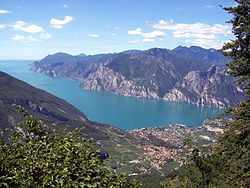Benacus
|
Lago di Garda Lake Garda |
|
|---|---|

Nago–Torbole and the northern part of the lake
|
|
| Location | Northern Italy |
| Coordinates | 45°38′N 10°40′E / 45.633°N 10.667°ECoordinates: 45°38′N 10°40′E / 45.633°N 10.667°E |
| Primary inflows | Sarca |
| Primary outflows | Mincio |
| Catchment area | 2,350 km2 (910 sq mi) |
| Basin countries | Italy |
| Max. length | 51.6 km (32.1 mi) |
| Max. width | 16.7 km (10.4 mi) |
| Surface area | 369.98 km2 (142.85 sq mi) |
| Average depth | 136 m (446 ft) |
| Max. depth | 346 m (1,135 ft) |
| Water volume | 50.35 km3 (40,820,000 acre·ft) |
| Residence time | 26.8 years |
| Shore length1 | 158.4 km (98.4 mi) |
| Surface elevation | 65 m (213 ft) |
| Islands | 5 (Isola del Garda, Isola San Biagio) |
| Settlements | see article |
| 1 Shore length is not a well-defined measure. | |
Lake Garda (Italian: Lago di Garda [ˈlaːɡo di ˈɡarda] or Lago Bènaco, Latin: Benacus; Lombard: Lach de Garda; Venetian: Łago de Garda) is the largest lake in Italy. It is a popular holiday location and is located in northern Italy, about halfway between Brescia and Verona, and between Venezia and Milano. Glaciers formed this alpine region at the end of the last Ice Age. The lake and its shoreline are divided between the provinces of Verona (to the south-east), Brescia (south-west), and Trentino (north). The name Garda, which the lake has been seen referred to in documents dating to the eighth century, comes from the town of the same name. It is the evolution of the Germanic word warda, meaning "place of guard" or "place of observation."
The northern part of the lake is narrower, surrounded by mountains, the majority of which belong to the Gruppo del Baldo. The shape is typical of a moraine valley, probably having been formed under the action of a Paleolithic glacier. Although traces of the glacier's actions are evident today, in more recent years it has been hypothesised that the glacier occupied a previously existing depression, created by stream erosion 5 to 6 million years ago. The lake has numerous small islands and five main ones, the largest being Isola del Garda where in 1220 St. Francis of Assisi founded a monastery, in its place now stands a nineteenth-century building in the Venetian Gothic style. Nearby to the south is Isola San Biagio, also known as the Isola dei Conigli ("Island of the Rabbits"). Both are offshore of San Felice del Benaco, on the lake's western side. The three other main islands are Isola dell'Olivo, Isola di Sogno, and Isola di Trimelone, all farther north near the eastern side. The main tributary is the Sarca River, others include the Ponale River (fed by Lago di Ledro), the Varone/Magnone River (via the Cascate del Varone) and various streams from both mountain sides, while the only outlet is the Mincio River (79 metres (259 ft), at Bardolino). The subdivision is created by the presence of a fault submerged between Sirmione and Punta San Vigilio which is almost a natural barrier that hampers the homogenization between the water of the two zones.
...
Wikipedia
